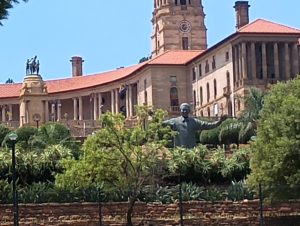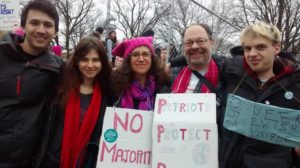5 Ways Nonviolent Resistance Works BETTER!
 Check out this TEDx talk by nonviolence researcher Erica Chenoweth. Chenoweth was originally quite hostile to nonviolent social change movements–until her own statistical analyses showed them (and us) that nonviolent resistance was far more effective than violent insurrection. Those who used it were more likely to achieve their goals, even “impossible” goals like unseating a government. AND they were more likely to achieve lasting change that didn’t just swing back with the next change in government. In fact, successful nonviolent revolutions were 15 percent more likely to avoid relapsing into civil war.
Check out this TEDx talk by nonviolence researcher Erica Chenoweth. Chenoweth was originally quite hostile to nonviolent social change movements–until her own statistical analyses showed them (and us) that nonviolent resistance was far more effective than violent insurrection. Those who used it were more likely to achieve their goals, even “impossible” goals like unseating a government. AND they were more likely to achieve lasting change that didn’t just swing back with the next change in government. In fact, successful nonviolent revolutions were 15 percent more likely to avoid relapsing into civil war.
This validates what people like Stephen Zunes, George Lakey, Barbara Deming, MLK, Gandhi (also not a pacifist in principle, but totally committed on the strategy, BTW), my late friends Dave Dellinger and Wally and Juanita Nelson, Harvey Wasserman, Anna Gyorgy, and many others have said for decades.
I think I can shed some light on why this is true:
1) You can’t outgun the state. They have tanks, WMDs, and lots of person-power. Engaging in violence is letting them choose the battlefield and the tools. You probably can’t outgun the Oath Keepers either, unless you ARE the state.
2) When the state attacks unarmed civilians, it has a jiu-jitsu effect of creating sympathy for those who are attacked (as is happening in Ukraine right now, and happened so dramatically in the US South in the 1950s and 60s). But when armed radicals attack the state, it creates support for the government, who can then marginalize and isolate the opposition as “terrorists”–and have an excuse to clamp down further on civil liberties.
3) When a government falls by force of arms, the conquerors want to make sure they aren’t taken out next. Thus, the pressure to become more dictatorial, which erodes popular support. I am old enough to remember when the Sandinistas, thugs like Zimbabwe’s Mugabe, and even the Iranian mullahs were welcomed as heroes by the local population, until they turned out to be just as vile as their predecessors, if not more. Some of my older mentors in my youth had watched the same pattern in the USSR, first under Lenin and then under the even crueler thumb of Stalin.
4) But when instead of fissioning society apart, a government seeks to actively unite people across the spectrum and build a better society for all, they can create new institutions that are nearly universally seen as working for the people, rather than the power structure. Such government initiatives typically draw their inspiration from long-term organizing by nonviolent people’s movements. I just returned from South Africa, and one of the people I met there had been a white soldier defending apartheid. Like everyone else I met, black or white, he had enormous respect and admiration for Nelson Mandela, the Truth and Reconciliation Commission, and the healing/unifying process after nearly 50 years of official apartheid (1948-94) and ingrained racism that dated back decades earlier. If this man, who carried a gun to protect white privilege, can embrace unity oriented black-majority governments, there is hope for all of us.
5) Nonviolent resistance is a shape-shifter. The forces of reaction can never fully predict how it will play out: what tactics and strategies will be invented, deployed, reinvented, and redeployed. It is extremely adaptable to circumstances. Decades ago, Gene Sharp codified a list of 198 nonviolent tactics. That was before the pandemic, and even before the Internet came into common use. A more recent list compiled by the King Center that continues the work of Martin Luther King, Jr. raises the number to 250. From the Old Testament refusal of the midwives Shifrah and Puah to carry out Pharaoh’s command to kill Hebrew baby boys–the first recorded act of civil disobedience that I’m aware of–to the creative use of vehicle caravans (often with only one or two occupants) as a way of demonstrating power and taking up space in the early days of the pandemic when it was unsafe to gather closely in the streets, nonviolent practitioners are natural tactical re-inventors.
Chenoweth points out one more thing: when open protest becomes too risky because of repression, concentration tactics like mass demonstrations may be augmented or replaced by dispersive tactics of quiet resistance (such as Ukrainians replacing road navigation signs with signage urging the Russian invaders to f themselves) that allow even elders, children, and people with disabilities to subvert the authoritarians.
And I personally have experienced the power of creative nonviolence over and over again, taking dozens of forms in movements or actions I participated in (and sometimes helped organize) and in moments of private personal action, including my mom castigating our landlord in front of 9-year-old me because she felt he was unwilling to rent to Blacks, my own one-person witness after the US bombed Libya. Some of these put me at personal risk, including standing with a small group of protestors in front of a much larger group that was hostile to us and probably included a number of people carrying firearms; in others, I took comfort in the strength of numbers. In all of them, I was convinced that nonviolence is more effective than violence in shaking up the power structure, and I’ve been part of winning campaigns (including, among others, the 1977 Seabrook Occupation and the 1999-2000 Save the Mountain campaign) often enough to see that truth validated.

